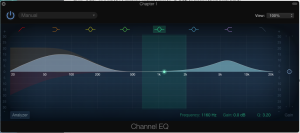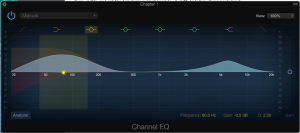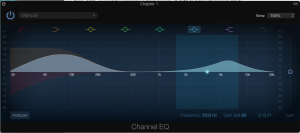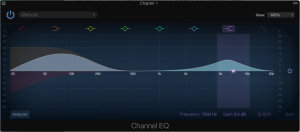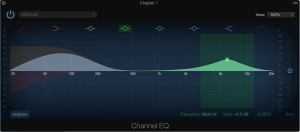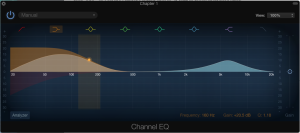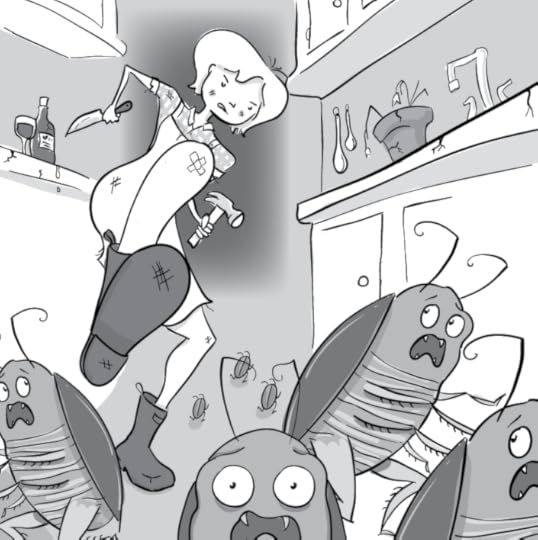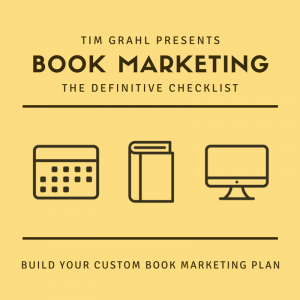Rob Dircks's Blog, page 8
March 5, 2016
How I sold 10,000 copies in one year (and maybe you can too).
My book Where the Hell is Tesla? launched exactly one year ago, and amazingly, it’s sold over 10,000 copies! I can hardly believe it myself, but when you look at the steps I took to get there, maybe it’s not so unbelievable after all. I’ve written a full post outlining everything I did over at GoldfinchPublishing.com
Read the full post at GoldfinchPublishing.com
February 24, 2016
Queens Library Presents… An Amazing Evening with Sci Fi/Fantasy Authors • March 8, 2016
Join us and meet some of NYC’s most creative and imaginative writers — Goldfinch Publishing’s own Rob Dircks, Ilana C. Myer and Alex Shvartsman. This evening will start with readings from the three amazing sci-fi authors. Following the readings will be a Q&A with the audience and finally a lively discission on a variety of topics focused on the role of science fiction in today’s pop culture such as “Are we in a second golden age of science fiction?”, “What’s the role of movies and science fiction?” and “Is science fiction becoming science fact?”
WHEN: Tuesday, March 8, 2016 at 6:00 PM – Tuesday, March 29, 2016 at 9:00 PM (EST) – Add to Calendar
WHERE: Manducatis Rustica – 46-35 Vernon Boulevard Long Island City, NY 11101 – View Map
Learn more and get tickets!
November 10, 2015
8 Ways to Make Your Writing Funnier (My Guest Post on Cat Rambo’s Site)
Recently, Cat Rambo (President of the Science Fiction and Fantasy Writers of America – SFWA – and World Fantasy and Nebula nominated speculative fiction writer) offered my a guest spot on her blog. Naturally, I jumped on the opportunity, and decided to offer something just about any writer could get a few tips from: injecting humor into your story.
But first, I didn’t set out to be a humorist. And I’ve only got one sci-fi comedy novel so far, Where the Hell is Tesla?, so I’m not sure I qualify as anyone you should listen to. But I’ve always loved funny sci-fi, like Douglas Adams’ The Hitchhiker’s Guide to the Galaxy, or John Scalzi’s Agent to the Stars, or Pratchett and Gaiman’s Good Omens, and I love the process of writing humor. It seems like a fit. I’m sticking with it.
Along the way, I’ve learned a ton from great writers, and great teachers, and from screwing up in every conceivable way. So here are a few of my favorite little nuggets that you might find it useful in your own writing:
Read the Full Guest Post at Cat Rambo’s Blog
October 28, 2015
My Garageband Settings for Audiobooks (ACX/Audible)
Hi folks! A while ago I posted about recording an audiobook for my novel Where the Hell is Tesla? (I used Garageband for recording and exporting to ACX/Audible.com). The post got a lot of positive response, and just the other day I got a request from Mark Clason for the actual settings I used in Garageband. I thought this was a great idea, but since Garageband has a kind of loosey-goosey user interface without a lot of specific numerical settings, I decided to do two things:
• 1. Here’s a link to download a sample Garageband 10.1 file
It’s got all my settings for a Master Track and a”Chapter 1″ track for your audiobook. Just load it up and give it a go!
• 2. Here are some Garageband screen shots/descriptions showing the settings and the (built-in) plugins that I used.
Special note: I am NOT a professional sound editor. I do have lots of experience recording voiceover and music, with professionals, but I’m the first one to say I don’t know everything, just enough to be dangerous, and for higher-end stuff I usually have other people at the controls. So if you see something here that looks wonky or wrong, let me know and I’ll update/fix it, so you’re more prepared to record your own audiobook.
1. Master Track – EQ
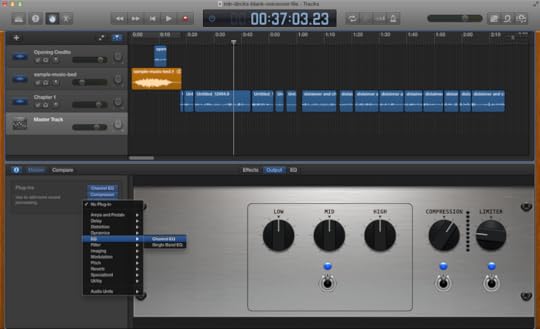
Make sure you can see your Master Track (Track > Show Master Track), then start editing your plugins (the Master Track already has plugins in there, you just have to turn them on). For EQ, I just left it flat, deciding instead to have individual EQ settings for each chapter, in case I wanted to tweak as I went. I didn’t tweak the individual chapters too much, however, so if you wanted to just use a master EQ, that should work no problem. (You can see my Chapter 1 EQ settings below.)
2. Master Track – Compressor
I turned on the Master Track Compressor. Applying compression to a track in Garageband lowers the volume of loud sounds to the same level as the quieter sounds. You can then raise the overall gain of the track, having reduced any peaks or troughs in the volume. I left the default settings:

Garageband Compressor settings for Audiobook Master Track
3. Master Track – Limiter
I turned on Limiter plugin. According to ACX production guidelines, “Each uploaded file must have peak values no higher than -3dB”, so I set the Limiter’s output level to -3.0db to follow their peak limit:
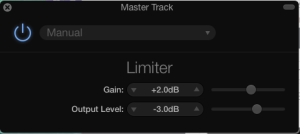
Garageband Limiter settings for Audiobook Master Track
4. Chapter 1 Track – EQ
Okay, that was it for the Master Track settings (though you can also play with the master volume, but we’ll get to that in a minute). For the Chapter 1 Track, (and all chapters started with these settings), I wanted to add bass to fill out the sound, give it some gravity, take out a little of the middle, or leave it flat, to make it less “mushy,” and punch up the high end just a little to make sure it was crisp and not overly bassy. I changed the default EQ values as follows: (Note that if you start a new Garageband file to record your audiobook and choose “Voice” as the project type, it’ll give you lots of tracks/options to play with.)
I totally recommend playing around with them visually, but if you want the exact numbers, download the sample Garageband file, or use these:
Frequency 92.0 Hz; Slope 24dB/Oct; Q: 0.20
Frequency 160.0 Hz; Gain +20.5 dB; Q: 1.10
Frequency 80.0 Hz; Gain -0.5 dB; Q: 2.20
Frequency 6000 Hz; Gain +9.5 dB; Q: 0.71
Frequency 1160 Hz; Gain +0.0 dB; Q: 3.20
Frequency 3500 Hz; Gain +0.0 dB; Q: 0.71
Frequency 7000 Hz; Gain +0.0 dB; Q: 0.71
5. Chapter 1 Track – Compressor
For each chapter track, I turned on the Compressor, and tweaked the values. I wish I could say there was a math to this, but I just did what sounded good. (Remember to use headphones, preferably good headphones, when tweaking values like this). Here are my values:
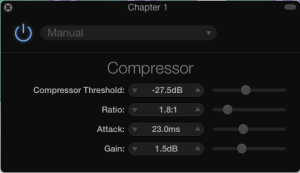
Garageband Compressor settings for Audiobook Chapter Track
6. Chapter 1 Track – Noise Gate
When you’re recording your audiobook, unless you’re in an amazing sound-proof room (which is awesome if you can get it), you’re going to have at least a little ambient room noise. Depending on your microphone and your recording levels, you can have quite a bit of control over this, but I found that I still needed a noise gate to cut off a certain low-end of noise so that I could have silence when there was supposed to be silence! (Although a wee little room noise can be okay, and sound perfectly natural, so don’t overdo the noise gate.) ACX wants your noise floor (the ambient noise level when there is no speaking or sound) to be no higher than -60db. So here are my settings: (Note that they change a bit from chapter to chapter.)
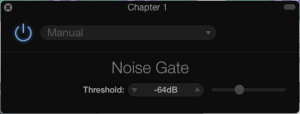
Garageband Noise Gate settings for Audiobook Chapter Track
7. Volume Control
You’ve got so many different places you can affect the volume: the Record Level on your input, and then for output you have your Master Track, Your individual Chapter tracks, and your Master volume.

Garageband Volume Controls for Audiobook
And none of these have numerical inputs (that I know of). So there’s no way around it: you’re going to have to play around with these inputs/outputs to get the right volume. (And you also have your headphone/speaker volume to contend with.) But this is the way I went about it:
• Left the Master Track output volume at default
• Started with Chapter track output volume at default
• Tested recording vocals, and played with the recording level to get this:

Garageband Volume Target for Audiobook
That’s a volume output that tends towards the upper-mid-to-high end of green, extends into the yellow for peak moments, but never goes into the red (though your Compressor and your Limiter should eliminate that anyway). I know this all sounds inexact, and it is, but it worked great for my audiobook, and I haven’t gotten a single comment from listeners about volume issues.
• Then tweak as necessary. Honestly, I didn’t worry about ACX’s instruction “Each uploaded file must measure between -23dB and -18dB RMS.” But as I said, I put a Limiter plug-in on the master track of -3.0db to follow their peak limit
8. Mastering/Export
I received a comment recently from someone concerned about the ACX / Audible.com “mastering” requirements. I’m not sure what they mean by this, as I didn’t do anything extraordinary on these files and they worked out great. As I showed above, I simply played with plugins on the Master and individual tracks. I guess you could call that mastering. (?) Then, I literally just exported with Share > Export Song to Disk > MP3/HighQuality 192 kBit/s. Boom. Done.
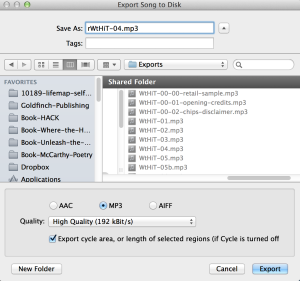
Garageband Export Settings for Audiobook ACX, Audible
Feedback from ACX and audiobook reviewers
My files, using the settings above, went through no problem. There were a couple of chapters that they kicked back, because I didn’t leave enough head and tail (beginning and end) silence. So I’d recommend a healthy 3 seconds of absolute silence at the beginning and end of each chapter.
As far as reviewers, I haven’t received a single negative comment about production quality, and in fact have gotten some really nice production-related feedback:
“★★★★★ The production quality is top-notch and the voices are spot on.”
“★★★★★ The narration is superb with a good range of voices.”
“★★★★★ This guy has a future writing and reading. I have over 500 audio books. This is right near the top of the heap.”
“★★★★★ In the company of recent great reads/listens like John Dies, Ready Player One, Lost and Found. I love this funny sci-fi stuff and the narration is fantastic.”
(If you’re so inclined, you can read some of the other 240 reviews of Where the Hell is Tesla? over at Audible.com. If you’re inclined to listen to a sample chapter, head on over. Oh, and of course you can purchase it there too. 
July 14, 2015
Book Review: On Mars: Pathfinder
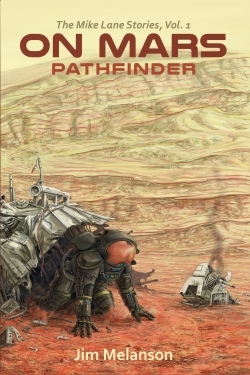 I recently read a book on vacation, a new sci-fi book by a talented new writer, Jim Melanson. His book, On Mars: Pathfinder, can be summed up in one word: EPIC.
I recently read a book on vacation, a new sci-fi book by a talented new writer, Jim Melanson. His book, On Mars: Pathfinder, can be summed up in one word: EPIC.
For the first quarter of the book, Jim Melanson creates a detailed, realistic world: the world of Mike Lane, brave astronaut, the first to land on Mars, in advance of future colonization efforts – or so you’re led to believe. This beginning reads much like The Martian by Andy Weir (and that’s a good thing) – a lone man surviving in a harsh land. Then Melanson blows the doors off the scenario: with human-alien hybrids, age-old intergalactic wars, secret bases, and even Earth-alien political intrigue. Wow! If you’re looking for some hard sci-fi that’s got all that, plus endearing characters, and lots of classic (and funny) sci-fi references, this is the book for you. And it’s the beginning of a truly epic saga- I look forward to more action from Mike Lane and more books from Jim Melanson. You can find the book here.
June 5, 2015
How I sold 1,000 copies of my book in three months (and maybe you can too).
x
If you’re like me, a relatively new author without a strong “platform,” no real fan base yet, and no influential connections so far to help promote your book, trying to put together a plan for selling it can be daunting. And if you manage to put something into action, how many copies should you expect to sell? A thousand? Twelve? None?
The goal I set for my novel Where the Hell is Tesla? was 1,000 copies sold in three months. And I did it. Here’s how.
First, though, a couple of thoughts:
If 1,000 copies in three months doesn’t sound like a lot, you’re right. It’s not. You can’t live on the profits from selling 11 copies of your book a day. But the average book now sells only 250 copies in an entire year, so my goal was actually pretty aggressive.
I’m not a book marketer. I’m a writer and a publisher. I’ll leave the marketing thinking to people like Tim Grahl, a book marketing consultant who’s helped New York Times bestselling authors for years.
Since I’m not a marketer, this is not a how-to-sell-1000-copies tutorial. This is my story, so far, for one book, and if you’re in a similar situation, I hope this post can help spark some ideas and sell a few more copies for you.
My goal was copies sold, not money earned. I spent money to sell copies. I still came out ahead. If you’re looking to launch a book without spending money, here’s a better way to do it.
My goal was copies sold, not copies given away. Free promos, through Amazon’s KDP free promotions for example, can get a LOT more copies into readers’ hands. But my opinion? Meh.
If you read this and get the idea “hey, everything this guy did worked,” you’re wrong. Most of what I tried didn’t work. Some did. If you want information about the stuff that didn’t work, contact me and I’d love to regale you with the 99 things I’ve learned not to do when launching your book.
Okay, let’s move on with the “pre-launch” stuff.
1. I wrote the book.
Before you can sell any copies, I’m going to assume you’ve written your book and published it. And I’d like to emphasize written. Where the Hell is Tesla? took me a year to write. It went through numerous revisions. I was correcting typos until the day before it launched. So make sure your primary goal, even before selling copies, is to craft a well-written story that will connect with readers, and make them laugh, or cry, or shiver with fear, or whatever. That’s the real point.
2. I set up my website, book landing page, social media, and Amazon pages.
I’d tell you all about how to build your own website in an hour, but Tim Grahl has already done that. So if you need to, check out his post and go to town. For my book, I use Goldfinch Publishing and RobDircks.com to help promote it, both WordPress sites. Contact me if you have any questions.
In addition to these sites, I’ve set up individual book landing pages I used when I needed to point to the book from a promotion — for example, my Facebook ads point to this landing page. (Notice that the only link on the entire page is to buy the book on Amazon. No navigation, no distractions.)
For social media, I’ve heard many people advise this and I’ll tell you the same thing: don’t overdo it. I have a full time job, I write and publish on the side, and even with just Facebook and Twitter, this book promotion thing was at times testing my productivity limits. So I stuck with those two, and I’d say go with the one or two that feel right for you. For example, if you’re creating a graphic novel — very visual — maybe Facebook and Pinterest would be your thing. Journalist writing non-fiction? Twitter.
For my Amazon author and book pages, I could get very detailed, but here’s the quick: Use the spaces Amazon gives you. Don’t leave things blank. Put plenty of key phrases in your book description and keywords list on your book sales page on Amazon. Hook up your author page to show your latest blog posts and tweets. Use what they give you.
Then I started blogging, posting, and tweeting. I’m not the best at this, but I’m trying, and I’m getting somewhere. And I think it’s helping sell copies.
3. I got more active on Goodreads.
Goodreads.com is a great site for authors and readers to connect. I joined new groups, contributed more often, and as you’ll see below, shared copies with groups, including print, digital, and audiobooks in exchange for even more reviews.
4. I lined up 25 Amazon reviews before launch.
Maybe the single biggest thing I did to help sell copies was get over 25 Amazon reviews ready for “launch date.” Here’s an excellent free course (from Tim Grahl, no surprise) that walks you through step-by-step. But in essence:
Contact 75 people you know and offer them a free advance digital copy of your book in exchange for an Amazon review.
Remind the people who say “yes” a couple of times, giving them time to finish reading it if they’ve procrastinated.
On launch day, send these people your book page link with instructions. If it works, you’ll get 25 reviews. I did.
Get a few close friends to upvote (honestly) some of your favorite reviews, so they stay on the book’s sales page as “most helpful,” not buried.
5. I published my book.
I plan to post a crash-course on formatting and publishing your book for print and digital editions, but I haven’t written that post yet, and I might never do it because there are a million resources out there that explain how to do it already. Of course, if you’re not the self-publishing type, that’s sort of the reason for Goldfinch Publishing. Contact me and I can help you edit, publish, and promote your book. Even if you want to do it completely on your own, I’m here to help.
Now, on to the “post-launch” stuff.
6. I enrolled in KDP Select to take advantage of Countdown Deals and KU/KOLL.
KDP Select (the KDP stands for Kindle Direct Publishing) incentivizes you to sell digital copies of your book exclusively through Amazon, in exchange for the ability to run their free promotions and Countdown Deals. From my first book, Unleash the Sloth!, I learned that 95% of my sales were coming from Amazon. So for this book, I decided to go exclusive and take advantage of the KDP Countdown Deals. My book is priced at $3.99, and the Countdown Deal allows you to price it temporarily at a discount – I chose $.99. I was able to time it so I got two countdown deals in the first three months, and timed my book email promotions (see #9) to sync with them. These represent, unsurprisingly, the two largest spikes in sales in those three months.
With KDP Select, I also earn royalties (counting as paid sales) on Kindle Unlimited and Kindle Owners’ Lending Library, which is not an insignificant number.
7. I gave copies away.
I know I just said that my goal wasn’t to give away free copies. And mostly I’m not sure what they do for me. But the Goodreads Giveaways are great. The site is for serious readers and authors, and you will get thoughtful reviews, likes, friends, and even enough of a rapport to get some fans onto your email list. (Oh, the email list thing — I’ll get to that in another post. It’s a work in progress.) And when one of these Goodreads members posts a review, all their friends see it.
In addition to the official Goodreads Giveaways, I’ve offered both free ebooks and free audiobook codes to the folks on Goodreads, inside groups. Posting a free offer in exchange for a review (in the appropriate places, not spamming the whole site) has worked wonderfully in getting reviews, and has definitely helped sell copies (even more so for the audiobook).
8. I begged for exposure.
This one kind of worked. If you read Tim’s book Your First 1,000 Copies, and put it to work, you’ll do better than me. (And I’ll do better next time, promise.) But luckily, a few things have dropped into place, and I’ve been interviewed for a couple of websites. I think the super-quick on this is to find people you know, or second-degree connections, or good targets, who have an audience of their own. Make the right request to them, and give them something that makes it easy for them to help you, like guest posts, podcast participation, and interviews.
9. I used paid promotions.
Until I can fully leverage my own audience, and the audiences of influencers that I connect with, I’ve supplemented my own efforts with paid promotions. And largely, it’s worked. Mostly I used book promotion sites that list deals, and send out daily emails to subscribers. Some post to social media as well.
BookBub – actually, I haven’t been able to get on this one yet. They only send out a small number of books in each email, and they’re very selective. Boo-hoo. I’ll keep trying.
BookGorilla.com – Cost $50. Sold lots of copies. Made money.
FussyLibrarian.com – Cost $15. Sold a bunch of copies. Made money.
BargainBooksy.com – Cost$35. Broke even.
Facebook ads – Cost up to $5 a day. Great for exposure. Sold some books. I wouldn’t bet the house on it.
Google ads – Cost up to $5 a day. Great for exposure. Sold some books. I wouldn’t bet the house on it.
I won’t list the ones that tanked, as I don’t want to slam a service that might just not have worked for me. But if you’re interested, let me know and I’ll give you the dark details.
10. I created an audiobook.
This one’s kind of funny. I really created the audiobook just to see if I could do it, and to make my Amazon book page look more complete. But boy was I surprised! It has sold way more than I expected, with no direct promotion at all. (Although I did offer free audiobook codes on Goodreads.com and got a terrific response. Have I mentioned that Goodreads is great?) If you’re interested, here’s my post about how you can produce your own audiobook.
Why is the audiobook performing? It turns out that audiobooks are on the rise, big time. And readers over at Audible are some serious readers. Check out this review from a recent reader/listener:
★★★★★ “Best Tesla-inspired Story In the Audio Stacks” — Fictionalized Tesla stories were in vogue a couple of years ago, but after listening to a few of them, I decided to forego purchasing any others because, far too often, they seemed overworked and boring. They took themselves, science, and Tesla wayyy to seriously. Tesla’s real life story held more intrigue than many of the fictional versions did. When I found the Dircks story, I listened to the excerpt out of a strange compulsion, possibly from mental programming from all the past Tesla tales. I’m glad I pushed the play button on this one. In my opinion, and despite all of the obligatory “dude” vulgarity, Dircks has written a laugh-out-loud, can’t stop listening story in which Tesla is given his due as a futurist and scientist, well ahead of his time. Chip and Pete are also fun characters with the type of “bro” friendship that would play well in a feature film. This is a slick, well-told tale. Could it have been told with less use of the “F” word? Absolutely. The potty humor was a bit overdone too. However, a real argument can be made that the characters are people we know and they certainly ring true to life, no cardboard stereotypes here. So,it’s all a matter of staying true to the characters, and the author did that. I’m hoping this is the first in a series. Would love a “What the blank Is Einstein Thinking?” or “Don’t Trust Edison!” If he could pull off the same kind of madcap, LOL intellectualism that he managed in the Tesla story, Dircks might just be the inventor of a new and very popular genre.
11. I celebrated.
After all the writing, editing, posting, promoting, and tallying, I reached 1,000 copies sold of Where the Hell is Tesla? and took a moment to celebrate. And then another. Pretty soon I was stinking drunk.
There you have it. If you’re on a similar path, I hope this post sparks some ideas. And if you have any questions at all, please don’t hesitate to reach out and ask me. I’m here to help.
June 3, 2015
Meet our New Author, Michael McCarthy
“While the novelist is banging on his typewriter, the poet is watching a fly in the windowpane.” –Billy Collins. Michael McCarthy is, in his words, “a lifelong explorer of the sacred.” Through a deepening poetic lens, he sees profound beauty in the commonplace. The ordinary is indeed richly extraordinary. He is a high school teacher of religion who lives on Long Island with his wife. He has degrees in theology and psychology.
March 29, 2015
Tim Grahl presents “Book Marketing – The Definitive Checklist”
At any given time, there seem to be 1,000 different ways to market your book. It’s not only hard to know what you should be doing. It’s also hard to keep up with all the options that are available.
After years of helping authors build their platforms, and then use those platforms to launch top bestsellers, Tim Grahl has put together this checklist of proven book marketing methods to help you create your book marketing plan.
March 27, 2015
Yes, You Can Record Your Own Audiobook. Here’s How.
x
When I finished writing and publishing Where the Hell is Tesla?, I looked at the Amazon.com book page, noticed the absence of an audiobook/CD, and said to myself “Hmmm. I wonder if I could do that myself?”
I found out I could. And guess what? You can too. You, an independent author, can narrate and publish your own audiobook — for free! (Or close.)
I won’t say it’s one-click easy, though. There are many small things to do right, and many small things that can make a recording awful. In fact, here’s a really smart article outlining numerous reasons why you SHOULDN’T narrate your own book. But if you’re still into it after reading that, any author that’s a bit technical can do it, without breaking the bank, using tools you already have (or that won’t cost you an arm and a leg to buy).
Before we get started:
You should already have your book done and published. If not, take care of that first and return to this post later. It’ll still be here!
You should have access to a computer or an iPad.
For my demonstration, I’m using certain gear and software you may not have, and I’m talking exclusively about Amazon, but the general principles will still apply.
This is meant to be an overview, not a tutorial. But I’m happy to answer any specific questions you have, so head on over to the Contact page and fire off a question at any time.
Okay, ready?
1. Create an account with ACX. ACX is part of Audible.com, an Amazon.com subsidiary. They help build and manage audio content that gets sold on Audible, Amazon, and iTunes. When you start your account, all you’ll need is your bank information (so they can pay you royalties — that’s a good thing), and to find your title in the Amazon database. Once you have your account created, take a look at the Audio Submission Requirements. Basically, know this:
You have to include separate opening credits, chapter files, closing credits, and a 1-5 minute sample.
Leave silence at the beginning and end of each chapter, and read the chapter headings aloud
Reduce noise on the low end, and make sure it’s not louder than -3dB (Don’t worry, I show you how in the video)
Export at 192kbps MP3 at 44.1kHz (again, it sounds hard but it’s easy)
2. Get your studio ready. Of course, by studio I mean anywhere you can set up. You’ll need:
A computer or an iPad. I use a Mac (my business is copywriting/design/advertising, so Macs are the standard), and as a recording author, this has a great benefit — because every Mac comes with…
Recording software. Garageband is the name of the app that comes free with a Mac. For more complicated projects at our studio, we use ProTools, but for a single voice, Garageband is perfect. Easy to use, even for beginners. And it comes free with iPads, too. If you’re working on a PC, you’ll need an alternative. I found this one that looks good: Mixcraft 7. And it’s only ninety bucks — cheap for recording software. That’s not an endorsement, but to let you know that recording options aren’t limited to mac folk.
A microphone. You could try to get away with the internal mic on your computer or iPad, but for a cleaner, less noisy sound… you’ll want to have a better mic. I use an AKG C3000 (about $200, there are a lot of good mics in this price range). But I also have a USB interface called a DUET2 that the mic plugs into (another $600). If you don’t feel like plunking down $800 before you’ve even started, here’s the good news: there are plenty of USB mics that are good enough for this work, and can plug directly into your computer or iPad. I found a great article comparing several, but here’s the quick — for a basic, good sound, try The Blue Microphones Snowball ($55). For a great mic that plugs directly into an iPad as well as a PC, try the Apogee MiC 96k ($229)
Headphones. If you want to monitor yourself (not a requirement, but a good idea), you’ll need a pair of headphones. From my experience, basic headphones should be fine.
A quiet space. This one’s common sense, and critical. Any extra room noise can ruin a recording, so choose a space with very little ambient noise. Also, open spaces with nothing on the walls can bounce the sound all over. Use blankets, foam, whatever you can to dampen the sound. (We use foam baffling circled pretty tightly around the microphone. You can see it in the video.)
3. Start recording! Fire up Garageband, create a new voice track, and go. Alternatively, I’ve created a Garageband file with the settings I use applied to the master track and first track. You can download it here. (40MB)
This isn’t meant to be a detailed tutorial on Garageband, so I won’t go into terminology, or every setting, but basically here’s what to set in everyday language:
Make sure your master volume just hits the “yellow” during loud moments, stays in the mid-to-high green area, and never hits the red.
Under Controls (the little dial-looking-button top left) make sure your “noise gate” is checked, and set to around -65dB (You can play with this setting to make sure you don’t get weird-sounding clipping, but make sure when you’re not talking, you don’t hear anything at all).
Also under controls, click on the compressor, the EQ, and give yourself a wee bit of reverb. (I show the dials and such in the video, but again, play with this to get the sound you like.)
Okay, when you’re ready to hit the record button and start speaking, keep these tips in mind:
Keep the mic about 6″ – 8″ from your face. You can play around with this. When you have to whisper, you can come in a little closer, and when you have to scream or shout, DEFINITELY pull back, and turn your head away from the mic a bit.
Make sure you’re speaking clearly, and make as few mistakes as possible. When you make a mistake, if it’s a small one, just leave a breath, say a quick “boop!” and repeat. This keeps your flow going, and gives you a visual cue when you go back to edit — the “boop!” shows up as a little spike in the waveform. For a larger mistake, stop recording, delete that range, and go again. If you do these two, you’ll thank yourself when you have to go through and edit all this!
Make sure your pace is not too fast and not too slow. Try it a few different ways, play it back. Let someone else listen to them and compare.
Minimize loud breath sounds, lip smacks, tongue clicks, pops and other noises. Again, you’ll thank yourself later when you don’t have to edit out all this. You can also buy a cheap pop filter (it’s in the video) that helps with some of this, mostly the “p” sound.
Keep characters, voices, and accents consistent, without making them too over-the-top or cartoony. (Although for my book, a comedy, I purposely went a bit over-the-top.). And keep the energy of performance consistent
Once you’ve recorded your opening credits, create a new track. Then for each chapter, do the same. So in the end, you’ll have a separate track for each chapter. This makes it easier to organize and export.
Note: If you want a quick music stinger for your opening credits, or a sound effect here and there, you can find tons of royalty free music beds and sfx on iTunes. There are lots of sites out there as well, LOTS, so if you feel like digging, go for it. Also for free sounds, my usual go-to site is SoundBible.com. Maybe not the biggest catalog, but it’s FREE, and it’s easy to use/download.
4. Edit and export your recordings. This is fun, but tedious, work. You’ll be taking out extra breath sounds, playing with volume and noise, a LOT. When you’re done (whew!) solo each track and export 192kbps MP3s at 44.1kHz (sounds complicated but it’s a couple of buttons).
5. Upload your files to ACX. Also might sound confusing, but it’s easy. You can see in the video, 1-2-3!
Then, once you’re done, you’re done. ACX takes over and packages up your files, and — assuming you don’t have any problems they come back to you with — they distribute it for you through Amazon, Audible, and Apple iBooks. And you earn a percentage of each sale — in my DIY case, 40%. Amazing!
If you have any questions at all about the process, I’d be happy to answer (or investigate if I don’t have an answer). Just head on over to the Contact page.
About the Book:
SCI-FI ODYSSEY. COMEDY. LOVE STORY. AND OF COURSE… NIKOLA TESLA. I’ll let Chip, the main character tell you more: “I found the journal at work. Well, I don’t know if you’d call it work, but that’s where I found it. It’s the lost journal of Nikola Tesla, one of the greatest inventors and visionaries ever. Before he died in 1943, he kept a notebook filled with spectacular claims and outrageous plans. One of these plans was for an “Interdimensional Transfer Apparatus” – that allowed someone (in this case me and my friend Pete) to travel to other versions of the infinite possibilities around us. Crazy, right? But that’s just where the crazy starts.”
CHIP’S OFFICIAL DISCLAIMER: This is a work of fiction: the events depicted in the collection of emails did not happen. I have never been in contact with a covert government group attempting to suppress knowledge of the lost journal of Nikola Tesla. I have not been threatened with death if I divulge the secrets contained inside. They did not buy me this handsome jacket (oh crap, you’re reading this – trust me, it looks great on me). They did not come to my place, and liquor me up, and offer to publish this book as a sci-fi comedy novel to throw the public off the trail of the real truth.
Or did they?
I’m kidding. Of course they didn’t.
Or did they?
God, I can’t keep my big mouth shut.
Praise for Where the Hell is Tesla?…
Where the Hell is Tesla? has been compared to Terry Pratchett (the Discworld Series), Douglas Adams’ Hitchhiker’s Guide to the Galaxy, and even Kurt Vonnegut (I know, that last one is probably a stretch.)
“If Bill and Ted were approaching middle age (and gotten just this much more world weary along the way), then went on an Even More Excellent Science Fact Adventure, you might get something like Rob Dircks’ debut novel, Where the Hell is Telsa? Smart, funny, and just like its titular scientist, impressively inventive, this is a must-read for anyone who aced science and, even more so, for those of us who didn’t. Which means, quite simply, it’s a book for everyone.”
– Michael Zam, Screenwriting Professor, NYU
“Reminds me of Vonnegut. Yeah, I said that.”
– Ruth Sinanian, Connoisseur of Fine Literature
Amazon.com Reviews…
“An extraordinarily unexpected delight… will appeal to fans of Pratchett and Adams.”
“A wild, witty wonderful ride through a historically accurate backdrop. You will laugh, it’s not dumb humor but very smart.”
“Very entertaining and a great homage to a great scientist. If you’re looking to laugh out loud while reading, then this is the book for you.”
“I was laughing at times and on the edge of my seat other times. The character of Chip is wonderful.”
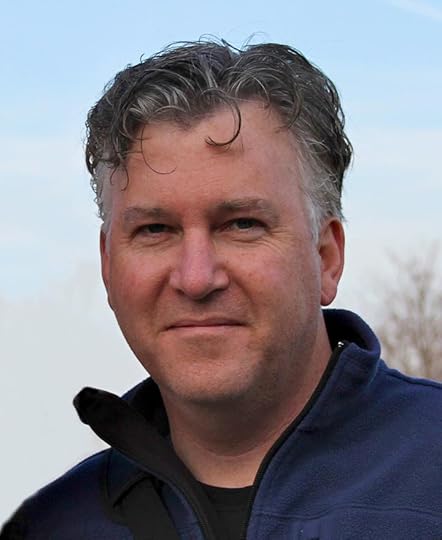
About Rob Dircks
Hi. I’m the owner of Goldfinch Publishing. After independently publishing my first two books, I fell in love with not only writing, but the new process of publishing. As a copywriter, designer, and developer for over twenty years, I realized I had some skills that might be able to help other authors. So in addition to hawking my own books (feel free to buy them here), I’ll be editing, producing, and promoting the works of other talented authors as well here on this site.
My past? I’ve been many things – author, advertising agency owner, aspiring screenwriter, stock video producer, iPhone app developer, photographer, and more. I was even a Sears baby photographer way back in college. (If I never see another red velvet baby Christmas dress, that’ll be just fine.) Feel free to reach out to me on the general Contact Us page, through the Goldfinch SELECT submission process, or with a request for information on paid services over at Goldfinch A LA CARTE.

